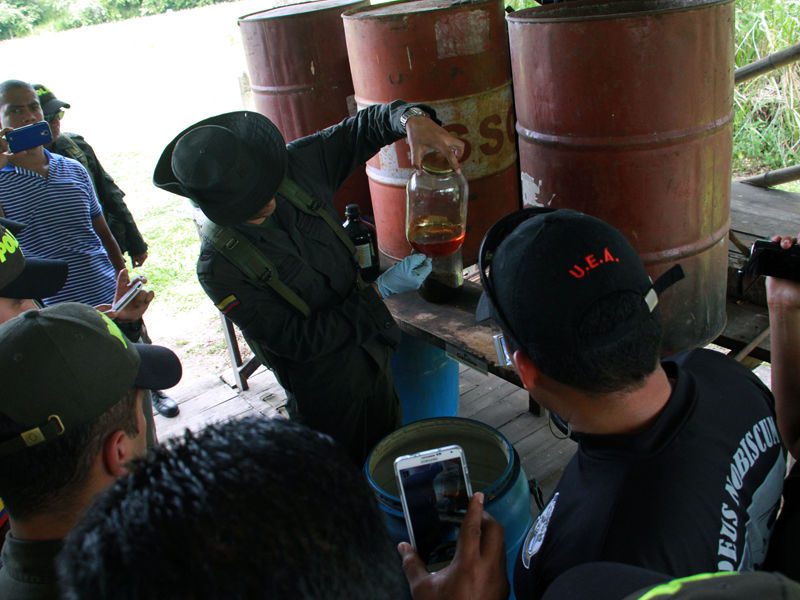
COLOMBIA NEWS – After nearly three decades combating narco-trafficking, the Colombian National Police (PNC) started sharing its experience with officers from other countries in the region in 2012.
From July 6-25, police from Argentina, Bolivia, Costa Rica, Chile, the Dominican Republic, Ecuador, Guatemala, Honduras and Mexico convened at the National Police Training and Research Center in Espinal in the department of Tolima.
The complex includes a controlled crop of coca, laboratories to study cocaine production, simulation camps with hidden caches, weapons and antipersonnel mines.
The center is in an area similar to where coca is normally grown in producer countries, while the laboratories are replicas of those found by Colombian authorities in the rain forest.
The course, which is offered five times a year, provides participants with a variety of tools to create preventive and operational strategies to fight drug trafficking. The course also can be attended by members of organizations engaged in combating narcotics consumption and trafficking.

The training teaches participants the drug chain in detail, from coca production to processing, trafficking and consumption, Lt. Col. Miguel Tunjano, the chief of the PNC Narcotics Division Detention Group, said.
“Colombia is a leader in the fight against drug trafficking,” Tunjano said. “After so many years with the very successful results we’ve had, we enjoy the trust of all the countries that come for training here, where sadly we have all the links in the production chain.”
The PNC is authorized by Colombia’s Drug Council to grow experimental coca crops for research, Tunjano said.
Thanks to these crops, officials trained in Colombia have improved their ability to follow the varieties of coca that are produced in the Andean nation. They can detect, for example, whether the crops are resistant to glyphosate – a broad-spectrum systemic herbicide used to kill weeds – in addition to facilitating detection from satellite images.
“By using satellite and aerial images, we have the technological capability and trained personnel to detect every parcel of coca,” Tunjano added. “This information allows us to plan much better for manual eradication operations and aerial spraying with glyphosate.”

As the permission to grow coca applies exclusively to Colombian territory, Tunjano suggested the program be followed in other countries with illegal crops.
“It’s important for these countries that are facing the problem of illegal crops to conduct this type of research,” he said. “It will allow them to understand their situation better, and if they understand their situation well, then it will be easier to fight it.”
The complex also has laboratories where officers learn about everything related to alkaloid processing and the tools used by drug traffickers to protect narcotics.
Additionally, officers can observe replicas of hidden caches where criminals often stash drugs and weapons, as well as the different types of antipersonnel mines that some criminals plant around their laboratories.
Colombia’s experience is very valuable for Bolivia, said Maj. Víctor Hugo Ramírez, a Bolivian police officer taking the course.
“The Colombian Police is well known in Bolivia, especially for its frontline battle against drug trafficking,” Ramírez said. “Drug traffickers don’t respect borders. This is a problem that has become global, and the world’s police must unify their efforts to fight this scourge on society.”
For Central American nations that are used as transit countries for drugs, police require training on all fronts to fight narco-trafficking effectively, Luis Alonso Ureña, a researcher with the Judicial Investigation Organization in Costa Rica, said.
“In Costa Rica, criminal groups, which are members of large cartels in Mexico and Colombia, find a territory where they can warehouse and hide drugs and raw materials,” he added.
This training, which is financed by the Organization of American States (OAS) Inter-American Drug Abuse Control Commission (CICAD), contributes to improved communications and cooperation among police throughout the region, Ureña said.

“Since Colombia is a producer country, it has created this link with us so we can know where the drug found in Costa Rica came from and to which organization it belongs,” he added.
This training is part of the Regional School for Anti-drug Intelligence of the American Community, an initiative developed by the OAS during the past 12 years, Rafael Parada, CICAD’s project manager, said.
Parada added the training also aims to develop prospective intelligence.
OAS’s support for these training courses is funded until 2016 and may be extended for another five years, said Maj. Miguel Ángel Godoy, the deputy director for the Regional School for Anti-drug Intelligence of the American Community.
At the end of the three-week training course, participants receive a certificate from the PNC, allowing them to use the knowledge to improve processes in the counter-narcotics fight in their countries, Godoy added.
A training session in Colombia is scheduled for September. Chile will host a course in October, with Mexico hosting one in December.
Source: Infosurhoy
